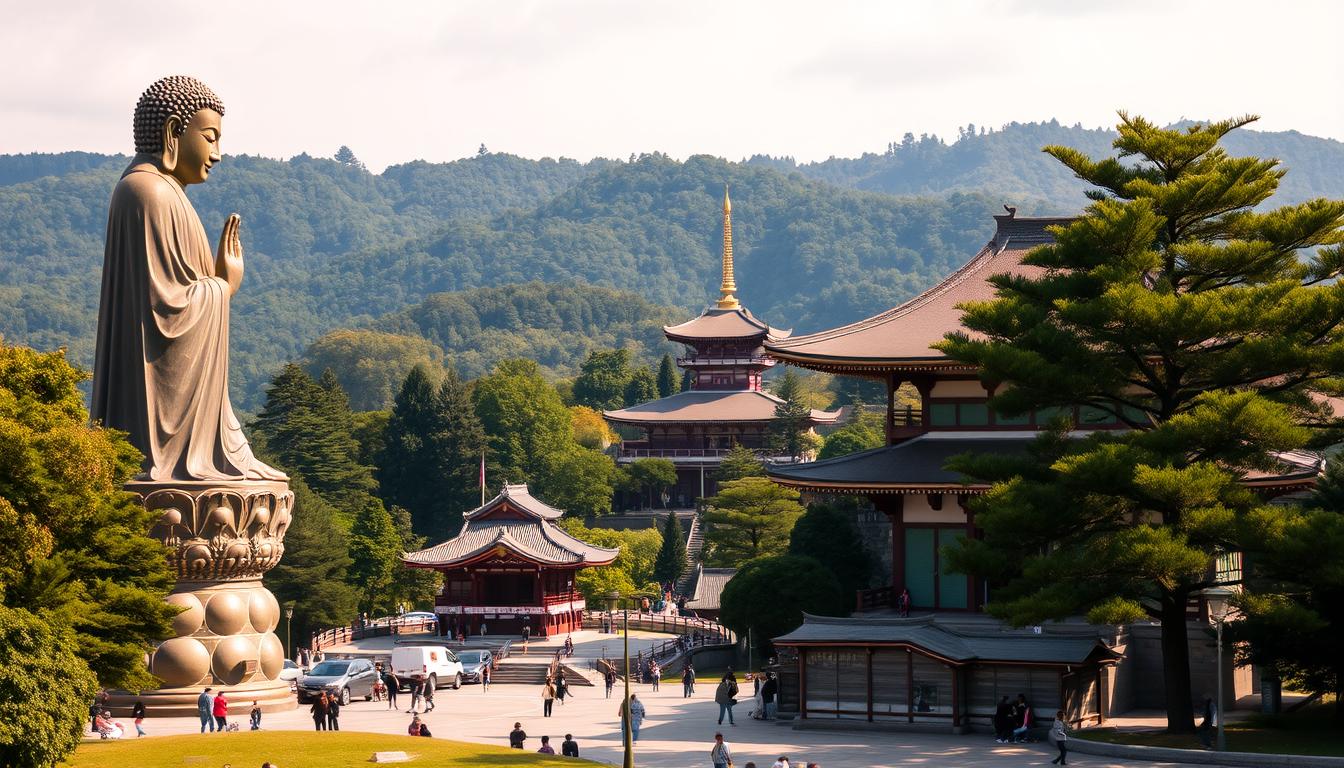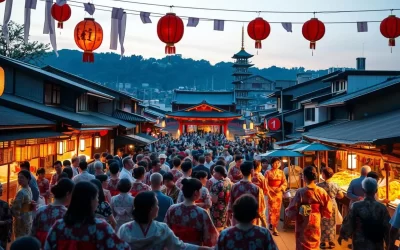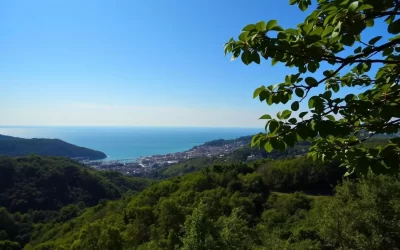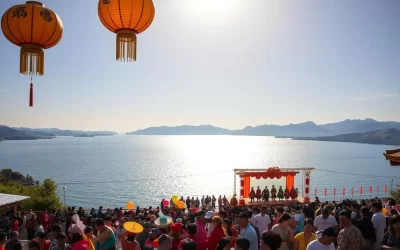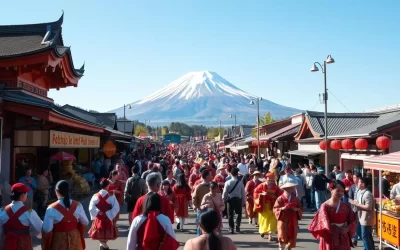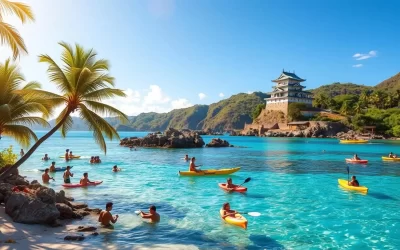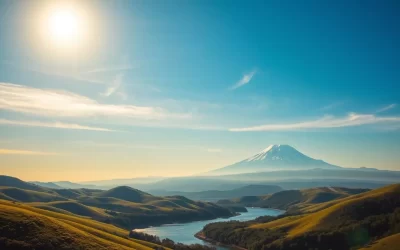Have you ever wondered what makes a small coastal town a timeless treasure? Just an hour from Tokyo, this destination offers a unique mix of history, culture, and natural beauty. From ancient temples to serene beaches, it’s a place where the past and present coexist harmoniously.
Once the political center of the country, this town is home to iconic landmarks like the Great Buddha and Tsurugaoka Hachimangu Shrine. Whether you’re exploring lush gardens or enjoying the local cuisine, every corner tells a story. This guide will help you navigate the best spots and make the most of your visit.
Ready to uncover the charm of this historic gem? Let’s dive into the must-see attractions and practical tips for an unforgettable experience.
Key Takeaways
- Discover historic temples and shrines with centuries of history.
- Enjoy scenic coastal views and relaxing beaches.
- Explore convenient transportation options for a smooth visit.
- Experience a blend of traditional culture and modern amenities.
- Find practical tips to enhance your travel experience.
Introduction to Kamakura’s Timeless Charm
Step into a city where history whispers through ancient temples and modern life hums along. Kamakura is a destination that effortlessly bridges the gap between the past and the present. With its rich heritage and vibrant culture, it’s a place that invites you to explore its timeless charm.
Once the political heart of the country, Kamakura is home to iconic landmarks like the Great Buddha and Tsurugaoka Hachimangu Shrine. These sites tell stories of a bygone era, while the bustling streets and local eateries reflect the energy of today. Whether you’re here for a day trip or an extended stay, the city offers something for everyone.
This guide provides all the information you need to make the most of your visit. From historic shrines to scenic coastal views, Kamakura is a treasure trove of experiences. Its unique blend of tradition and modernity creates an atmosphere that’s both relaxing and inspiring.
Ready to uncover the magic of this coastal gem? Let’s dive into what makes Kamakura a must-visit destination. Whether you’re a history buff, a nature lover, or simply looking for a peaceful escape, this city promises to leave a lasting impression.
Navigating Kamakura: Transportation and Getting Around
Getting around this historic town is easier than you might think. With a mix of trains, buses, and taxis, you can explore every corner without hassle. Whether you’re coming from Tokyo or moving locally, the transport options are reliable and convenient.
JR and Enoden Lines Overview
Reaching this destination from Tokyo is simple. The JR Yokosuka line takes about an hour, with fares starting at 940 yen. If you’re using a Japan Rail pass, this route is fully covered. For local travel, the Enoden line connects key spots like Fujisawa and Kamakura station in just 34 minutes.
Planning your route is easy with tools like Jorudan. These platforms provide real-time schedules and fare details. Exits at each station are well-marked, making it simple to find your way.
Local Bus and Taxi Options
Once you arrive, local bus services are a great way to get around. They cover most attractions and run frequently. Taxis are also available, though they’re best for shorter distances or when you’re in a hurry.
For a seamless experience, consider using a prepaid card like Welcome Suica. It works on trains, buses, and even some shops. With these options, exploring this charming town is both easy and enjoyable.
Iconic Temples and Shrines to Visit
Discover the spiritual heart of this historic town through its iconic temples and shrines. These sacred sites are not just architectural marvels but also windows into the past, offering a glimpse of the town’s rich cultural heritage.
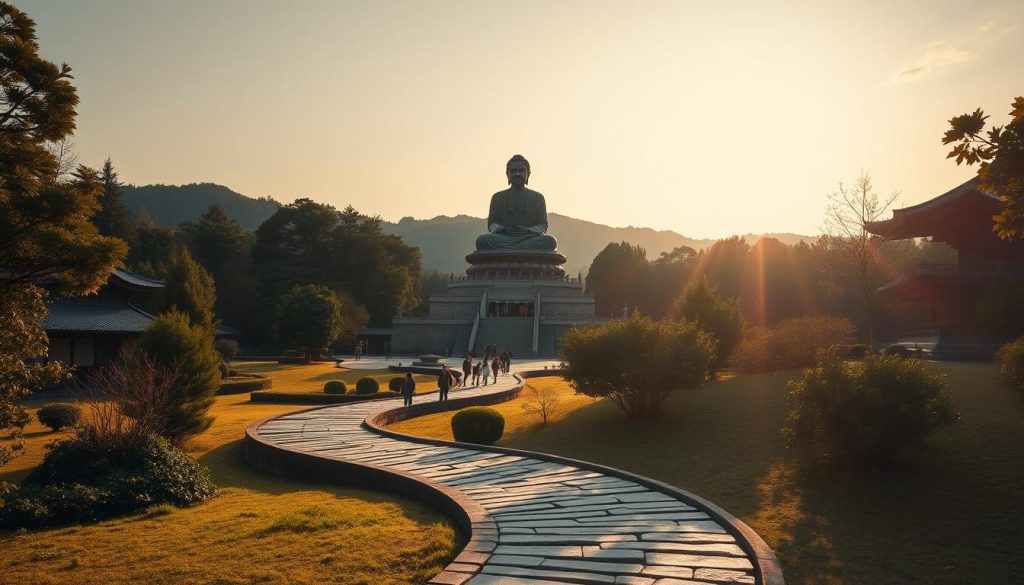
Tsurugaoka Hachimangu Shrine Insights
As one of the most significant shrines in the area, Tsurugaoka Hachimangu holds a special place in the town’s history. Founded in 1063 and relocated in 1180, it became a symbol of power during the Kamakura period. The shrine is dedicated to Hachiman, the god of war and protector of the samurai.
Its grand architecture, including the iconic red torii gate and spacious grounds, creates a serene atmosphere. Visitors often come here to pray for good fortune, especially during the New Year’s hatsumode festival. The shrine’s central location makes it a convenient starting point for exploring other landmarks.
Kotoku-in and the Great Buddha
No visit is complete without seeing the Great Buddha at Kotoku-in. This towering statue, standing at 11.4 meters, was cast in 1252 and has become a symbol of the town’s spiritual legacy. Originally housed in a temple, the Buddha now sits in the open air, surrounded by lush greenery.
For a small fee, you can even step inside the statue to see its intricate construction. The peaceful surroundings and the Buddha’s serene expression make this a must-visit spot for reflection and photography.
| Site | Admission Fee | Opening Hours |
|---|---|---|
| Tsurugaoka Hachimangu Shrine | Free | 5am – 9pm (Oct-Mar: 6am – 9pm) |
| Kotoku-in (Great Buddha) | ¥300 | 8am – 5:30pm |
Whether you’re drawn to the history of Tsurugaoka Hachimangu or the awe-inspiring presence of the Great Buddha, these sites offer a profound connection to the town’s spiritual and cultural roots. Plan your visit early to avoid crowds and fully immerse yourself in the experience.
Experience the Natural Beauty of Bamboo Groves
Immerse yourself in the tranquil beauty of nature at Hokoku-ji’s bamboo grove. This serene spot offers a peaceful escape, where the rustling of bamboo leaves creates a calming atmosphere. It’s a place where you can truly connect with nature and find a moment of quiet reflection.
Hokoku-ji Bamboo Grove and Tea House
The bamboo forest at Hokoku-ji is a stunning example of natural beauty. Walking through the towering bamboo stalks, you’ll feel a sense of peace and wonder. The grove is compact yet enchanting, making it easy to explore and enjoy.
Bamboo holds a special place in Japanese culture. It’s often associated with strength, flexibility, and resilience. In traditional gardens, bamboo is used to create a sense of harmony and balance. At Hokoku-ji, the bamboo forest enhances the temple’s serene atmosphere, making it a perfect spot for meditation and relaxation.
After your walk, visit the on-site tea house. Here, you can enjoy a cup of matcha and sweet treats. The tea house offers a traditional experience, allowing you to savor the flavors of Japan while surrounded by nature. It’s a delightful way to end your visit.
The temple grounds are beautifully maintained, with pathways that guide you through the grove. Every corner of Hokoku-ji invites you to pause and appreciate the natural beauty. Take your time to explore and soak in the peaceful ambiance.
“In the midst of the bamboo grove, one finds a rare tranquility that soothes the soul.”
Visiting Hokoku-ji is more than just a sightseeing trip; it’s an opportunity to connect with nature and experience the cultural significance of bamboo. Whether you’re a nature lover or simply seeking a moment of peace, this bamboo forest is a must-see in Kamakura.
Historical Highlights and Cultural Insights
Travel back in time to explore the roots of a historic coastal town. Kamakura’s legacy as the political center of the Kamakura Shogunate is a cornerstone of its identity. From 1185 to 1333, this town shaped regional governance and culture, leaving a lasting impact on Japan’s history.
The year 1185 marked the beginning of the Kamakura Shogunate, a period defined by samurai rule and Zen Buddhism. This fusion of military power and spiritual practice created a unique cultural landscape. Key dates like 1192, when Minamoto no Yoritomo became shogun, highlight transformative moments in the town’s history.
Samurai legacy and Zen Buddhism remain foundational influences. The samurai’s code of honor, bushido, and Zen’s emphasis on mindfulness continue to shape modern culture. These elements are evident in the town’s temples, shrines, and even its approach to heritage preservation.
“The Kamakura Shogunate was not just a political shift; it was a cultural revolution that defined an era.”
Today, Kamakura’s historical sites offer a glimpse into its storied past. From ancient battlefields to serene temples, every corner tells a story. This trip through time connects the town’s turbulent history with its peaceful present, making it a must-visit for history enthusiasts.
Whether you’re exploring the Great Buddha or walking through Tsurugaoka Hachimangu Shrine, you’re stepping into a living history book. Kamakura’s ability to preserve its heritage while embracing modernity is a testament to its enduring charm.
Kamakura, Japan: Best Things to Do – Top Picks
From ancient landmarks to modern delights, this coastal gem offers something for everyone. Whether you’re a history buff, a foodie, or an outdoor enthusiast, there’s no shortage of experiences to enjoy. This guide will help you uncover the best attractions and hidden treasures that make this city so special.
Diverse Attractions Across the City
Start your journey with the iconic Great Buddha, a towering symbol of the town’s spiritual heritage. Then, head to Tsurugaoka Hachimangu Shrine, where history and culture come alive. For a taste of modern life, explore Komachi Street, a bustling hub of shops, cafes, and restaurants.
Don’t miss the chance to visit Hokoku-ji’s bamboo grove, a serene spot perfect for reflection. If you’re a nature lover, Yuigahama Beach offers stunning coastal views and a relaxing atmosphere. Each attraction tells a unique story, making your visit unforgettable.
Uncovering Hidden Gems
Beyond the well-known sites, there are plenty of lesser-known treasures waiting to be discovered. Zeniarai Benten Shrine, with its unique money-washing ritual, is a fascinating spot many travelers overlook. For a quiet escape, visit Meigetsuin Temple, also known as the “Hydrangea Temple,” especially during the blooming season.
Foodies will love exploring local restaurants serving traditional dishes like pressed octopus crackers. These hidden gems add depth to your experience, offering a glimpse into the town’s authentic charm.
“The true beauty of this destination lies in its ability to surprise and inspire, even in the most unexpected places.”
Use this guide as your checklist to ensure you don’t miss a single thing. Whether you’re here for a day or a week, this city promises to leave a lasting impression. So, pack your bags and get ready to explore the best of what Kamakura has to offer!
Relax on Beautiful Beaches and Seaside Views
Escape the hustle and unwind on the serene shores of Kamakura’s coastal gems. Whether you’re soaking up the sun or exploring a nearby island, these spots offer the perfect blend of relaxation and adventure. From sandy stretches to scenic viewpoints, there’s something for everyone to enjoy.
Yuigahama Beach Vibes
Yuigahama Beach is a favorite for locals and visitors alike. Its long sandy shore is ideal for sunbathing, swimming, or simply strolling along the water’s edge. The laid-back atmosphere makes it a great spot to unwind after a busy day of exploring.
During the summer months, the beach comes alive with seasonal events and activities. From beach volleyball to evening bonfires, there’s always something happening. Plus, its proximity to the train station makes it easy to access, even if you’re short on time.
Enoshima Excursions
For a change of pace, hop on the Enoden line and head to Enoshima. This small island is just a short train ride away and offers stunning coastal views, lush gardens, and charming shrines. It’s the perfect complement to a day at the beach.
Once on the island, explore its walking trails, visit the Enoshima Shrine, or enjoy fresh seafood at one of the local restaurants. The observation deck provides panoramic views of the ocean, making it a must-see spot for any trip.
“The sound of waves and the salty breeze create a sense of calm that’s hard to find elsewhere.”
| Location | Accessibility | Best Time to Visit |
|---|---|---|
| Yuigahama Beach | 5-minute walk from Kamakura Station | Summer (June-August) |
| Enoshima | 15-minute train ride via Enoden line | Year-round (Spring for flowers, Fall for foliage) |
Whether you’re spending the day at Yuigahama or exploring Enoshima, these coastal destinations offer a refreshing escape. Pack your sunscreen, grab your camera, and get ready to create unforgettable memories by the sea.
Scenic Hiking and Outdoor Adventures
Lace up your hiking boots and explore the scenic trails that weave through this historic town. These paths offer a unique way to experience both natural beauty and cultural landmarks. Whether you’re a seasoned hiker or just looking for a leisurely walk, there’s a trail for everyone.
Popular Hiking Trails in the Kamakura Valley
The Daibutsu Hiking Trail is a favorite, connecting iconic sites like the Great Buddha and Hasedera Temple. This route takes about 60–90 minutes and is well-marked, making it easy to follow. Along the way, you’ll pass through lush forests and enjoy stunning views of the surrounding landscape.
Another great option is the Tenen Hiking Trail, which winds through Shishimai Valley and ends at Zuisenji Temple. This trail also takes around 60–90 minutes and offers a peaceful escape from the busier parts of town. For a shorter hike, try the Gionyama Hiking Trail, which starts at Myohonji Temple and leads to Yagumo Shrine. This 30-minute walk is perfect if you’re short on time.
Nature Walks Among Ancient Shrines
Many trails pass by ancient shrines and temples, adding a spiritual dimension to your hike. These paths are not just about physical activity; they’re also a guide to the town’s rich history. Walking these routes, you’ll feel a deep connection to the past and the natural world.
For a unique experience, explore lesser-known trails like the ones around Meigetsuin Temple. These quieter paths offer a chance to enjoy the beauty of Kamakura without the crowds. Whether you’re hiking for exercise or reflection, these trails provide a memorable outdoor adventure.
“Walking through these trails is like stepping into a living history book, where every step tells a story.”
Here’s a quick guide to help you plan your hike:
- Daibutsu Trail: 60–90 minutes, moderate difficulty.
- Tenen Trail: 60–90 minutes, moderate difficulty.
- Gionyama Trail: 30 minutes, easy.
Whether you’re here for the views, the history, or the exercise, hiking in Kamakura is an unforgettable experience. So grab your gear and hit the trails!
Exploring the Vibrant Shopping Streets
Stroll through the heart of a historic town where shopping meets culture. Kamakura’s main streets, like Komachi-dori, are transformed into lively shopping avenues. Here, you’ll find a mix of traditional crafts, local delicacies, and unique souvenirs that reflect the town’s rich heritage.
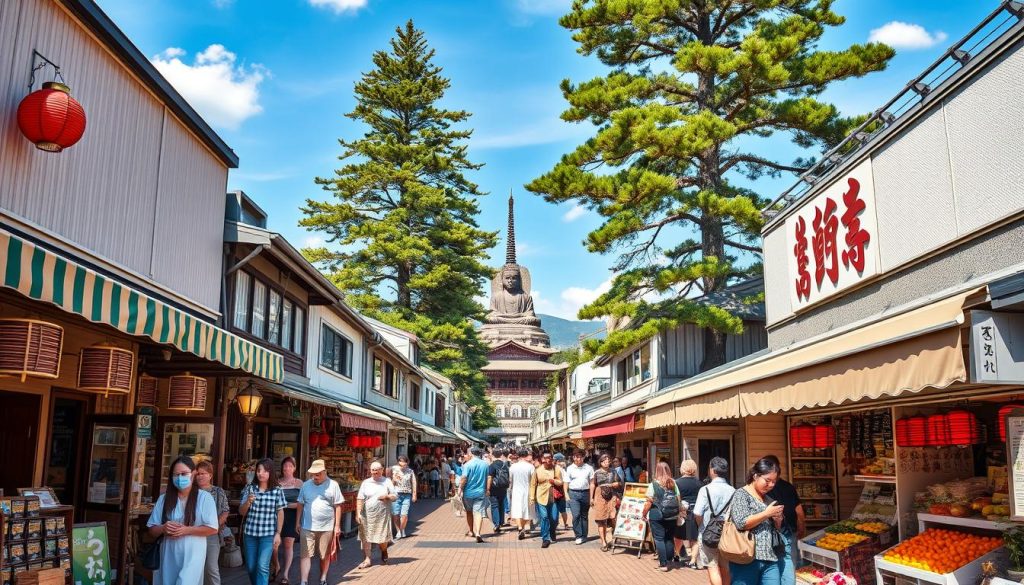
These bustling streets are more than just shopping destinations. They are deeply connected to the town’s famous temples and shrines. For centuries, these areas have served as hubs for pilgrims and travelers, offering goods and refreshments. Today, they continue to thrive, blending history with modern charm.
During festivals and peak tourist seasons, the ambiance is electric. Lanterns light up the streets, and vendors offer seasonal treats. It’s a perfect time to experience the local culture and pick up one-of-a-kind items.
Here are some must-visit spots:
- Komachi-dori: A lively street filled with shops selling everything from snacks to handmade crafts.
- Local Markets: Discover fresh produce and traditional goods.
- Specialty Stores: Find unique items like pressed octopus crackers and artisanal pottery.
“The streets of Kamakura are a treasure trove of culture, history, and unique finds.”
| Location | Highlights | Best Time to Visit |
|---|---|---|
| Komachi-dori | Souvenirs, snacks, crafts | Weekdays (less crowded) |
| Local Markets | Fresh produce, traditional goods | Morning hours |
| Specialty Stores | Unique local products | Year-round |
Whether you’re hunting for souvenirs or simply soaking in the vibrant atmosphere, Kamakura’s shopping streets offer an unforgettable experience. Take your time to explore and uncover the hidden gems that make this town so special.
Unique Culinary Delights and Must-Try Restaurants
Savor the unique culinary traditions that make this destination unforgettable. From cozy cafés to upscale restaurants, the dining scene here offers a delightful mix of flavors. Whether you’re craving traditional Japanese dishes or modern fusion, there’s something for every palate.
One thing you’ll notice is the variety of local specialties. Try the pressed octopus crackers, a unique snack found in many shops. For a heartier meal, don’t miss the Kuroge Wagyu steak, known for its rich marbling and tender texture.
Local Eateries and Cafés
The culinary scene in Kamakura is as diverse as it is delicious. Start your day with a traditional Japanese breakfast at a local café. Many places serve miso soup, grilled fish, and rice, offering a taste of authentic flavors.
For lunch, head to a casual restaurant and try the Mikaku Gozen course. This seasonal meal features seven dishes, each representing a different aspect of Japanese cuisine. It’s a great way to experience the local culture through food.
Dinner options range from izakayas to fine dining. At Ohama izakaya, you can enjoy a variety of sake brands paired with small plates. For a more upscale experience, try the Kissho course, available for both lunch and dinner.
“The flavors of Kamakura are a journey through time, blending tradition with innovation.”
Here are some tips for navigating the dining scene:
- Book ahead: Popular spots fill up quickly, especially during peak hours.
- Explore side streets: Hidden gems often lie off the main roads.
- Try seasonal dishes: Menus change to reflect the freshest ingredients.
Exploring the culinary scene is an essential part of any trip to Kamakura. Whether you’re a foodie or just looking for a great meal, the town’s restaurants and cafés promise an unforgettable experience.
Day Trip Itineraries and Modular Experiences
Plan your perfect getaway with customizable day trip options. Whether you’re visiting for a few hours or a full day, these modular itineraries let you explore at your own pace. Tailor your schedule to match your interests and make the most of your time in this historic town.
Half-Day Modules for Maximum Exploration
Start your adventure with a morning module focused on iconic landmarks. Visit the Great Buddha and Tsurugaoka Hachimangu Shrine, both easily accessible from Kamakura Station. These sites offer a deep dive into the town’s spiritual and cultural heritage.
For an afternoon module, head to Hokoku-ji’s bamboo grove or Yuigahama Beach. These spots provide a peaceful escape and a chance to connect with nature. Each module is designed to fit seamlessly into your schedule, ensuring a stress-free experience.
Optimizing Your Visit Schedule
To avoid crowds, plan your visits early in the morning or late in the afternoon. Popular spots like the Great Buddha and Komachi Street can get busy, so timing is key. Use the Enoden line to connect attractions quickly and efficiently.
Mix and match modules to create a trip that suits your interests. Whether you’re a history buff, a nature lover, or a foodie, there’s a module for you. With these flexible options, you can explore the best of Kamakura without feeling rushed.
“Customizing your itinerary ensures you see what matters most to you, making every moment count.”
Here’s a quick guide to help you plan:
- Morning Module: Great Buddha, Tsurugaoka Hachimangu Shrine.
- Afternoon Module: Hokoku-ji Bamboo Grove, Yuigahama Beach.
- Evening Module: Komachi Street for shopping and dining.
With these modular options, your day trip will be both enjoyable and efficient. Start planning today and get ready for an unforgettable adventure!
Experiencing Traditional Festivals and Local Events
Immerse yourself in the vibrant traditions of a historic town through its lively festivals and events. From fireworks at Yuigahama Beach to temple celebrations during peak bloom, these gatherings are timed to honor seasonal beauty and cultural heritage. Whether you’re visiting in summer or autumn, there’s always something special to experience.
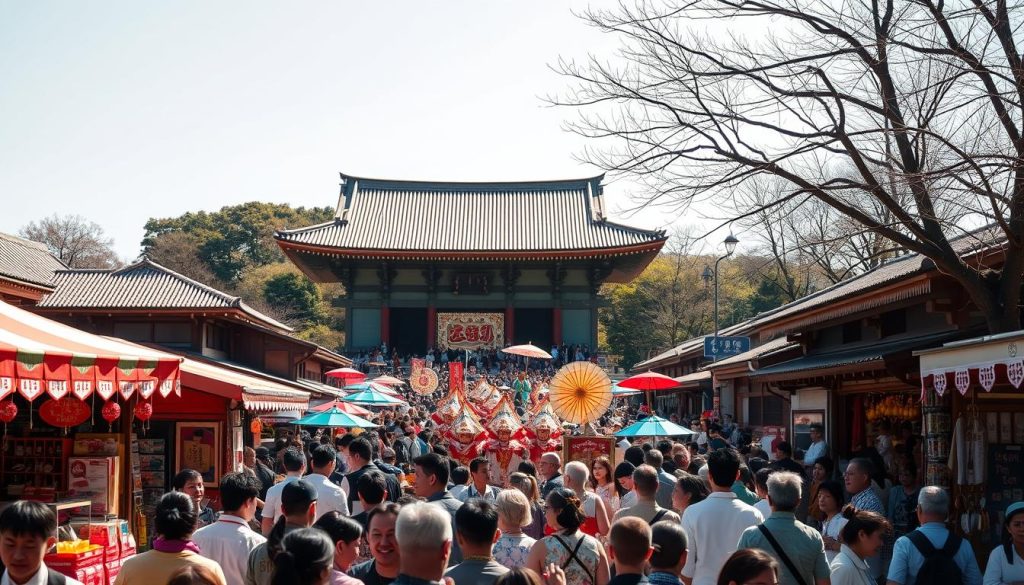
Seasonal Festivals in Kamakura
Kamakura’s festivals are deeply tied to its natural surroundings and history. In June, the Ajisai Matsuri celebrates the blooming of hydrangeas, transforming temples into colorful displays. This event is a favorite among locals and visitors alike, offering a chance to enjoy the town’s floral beauty.
Summer brings the Yuigahama Fireworks Festival, held in late July. The sky lights up with dazzling displays, creating a magical atmosphere by the beach. It’s a perfect way to spend a warm evening, surrounded by the sounds of celebration.
Cultural Celebrations to Look For
In August, the Obon Festival takes center stage. This event honors ancestral spirits with traditional dances, lanterns, and food stalls. It’s a time for families to come together and celebrate their heritage, making it a deeply meaningful experience.
Another highlight is the Kamakura Matsuri, held in April. This week-long event features parades, performances, and ceremonies that reflect the town’s samurai and Buddhist roots. It’s a fantastic opportunity to witness traditional arts and crafts up close.
“Festivals in Kamakura are more than just events; they’re a window into the town’s soul, blending history, culture, and community.”
Here’s a quick guide to help you plan your visit:
| Festival | Date/Month | Highlights |
|---|---|---|
| Ajisai Matsuri | June | Hydrangea blooms, temple visits |
| Yuigahama Fireworks | Late July | Fireworks, beachside celebrations |
| Obon Festival | August 13th-16th | Bon dances, lanterns, food stalls |
| Kamakura Matsuri | April | Parades, traditional performances |
To make the most of your trip, arrive early during popular festivals to avoid crowds. Use this guide to plan your visit around key dates and immerse yourself in the town’s rich cultural tapestry.
Art, Crafts, and Local Workshops
Dive into the creative heart of this historic town with hands-on workshops and artisan treasures. Whether you’re crafting a personal souvenir or exploring unique stationery, these activities add an interactive element to your trip. Discover how local artisans preserve traditions while offering visitors a chance to create something special.
Pottery Classes and Handicraft Workshops
Join a pottery class and learn the art of shaping clay into beautiful pieces. Many workshops focus on creating statues, including miniature Buddha figures, which make for meaningful keepsakes. These sessions are led by skilled artisans who share their expertise and passion for traditional crafts.
For a unique experience, try gold-leaf workshops where you can decorate items like chopsticks or small ornaments. These classes typically last 20 to 35 minutes and cost between ¥800 and ¥1,800. Reservations are recommended, especially on weekends.
Unique Stationery and Artisan Finds
Stroll through quaint shops and discover one-of-a-kind stationery and artisan goods. From hand-painted paper to intricate porcelain pieces, these items reflect the town’s artistic heritage. Many shops also offer workshops where you can try your hand at crafting your own designs.
If you’re a fan of traditional Japanese crafts, visit local markets for fresh produce and handmade goods. These spots are perfect for finding unique gifts or souvenirs that capture the essence of your trip.
“Creating something with your own hands connects you to the culture in a way that’s both personal and profound.”
Here’s a quick guide to help you plan your creative adventure:
- Pottery Classes: Learn to craft statues or functional pieces, starting at ¥1,300.
- Gold-Leaf Workshops: Decorate items like chopsticks, starting at ¥800.
- Stationery Shops: Browse unique finds and join crafting sessions.
These workshops and shops provide a deeper connection to the town’s culture and history. Whether you’re a seasoned artist or a curious beginner, there’s something for everyone to enjoy.
Historical Insights: From Samurai Legacy to Zen Buddhism
Uncover the rich tapestry of history that shaped a town known for its samurai legacy and Zen traditions. This coastal gem is more than just a scenic destination; it’s a living testament to centuries of cultural evolution. From ancient warriors to spiritual practices, every corner tells a story of resilience and transformation.
Ancient Warrior Tales and Landmarks
The samurai era left an indelible mark on this town. Once the political center of the Kamakura Shogunate, it became a hub for warriors and leaders. Key landmarks like the Tsurugaoka Hachimangu Shrine stand as reminders of this powerful past. Founded in 1063, this shrine was a focal point for samurai rituals and governance.
Another iconic site is the Inari Shrine, known for its red torii gates and spiritual significance. These shrines were not just places of worship but also symbols of authority and protection. Walking through these grounds, you can almost hear the echoes of ancient battles and strategic decisions.
Zen Influences on Modern Culture
Zen Buddhism played a pivotal role in shaping the town’s cultural identity. Introduced during the Kamakura period, it influenced art, architecture, and daily life. Temples like Engaku-ji and Kencho-ji became centers for Zen practice, attracting monks and scholars from across the region.
Today, the principles of Zen continue to inspire. From minimalist gardens to mindful practices, the town’s spiritual heritage is woven into its modern fabric. Visiting these temples offers a chance to reflect and connect with a tradition that has endured for centuries.
“The legacy of the samurai and the teachings of Zen are threads in the tapestry of this town’s history, each adding depth and meaning to its story.”
Here’s a quick guide to key historical sites:
- Tsurugaoka Hachimangu Shrine: A symbol of samurai power and spiritual devotion.
- Inari Shrine: Known for its vibrant torii gates and cultural significance.
- Engaku-ji Temple: A center for Zen practice and meditation.
Exploring these sites allows you to step into the past and appreciate the town’s enduring legacy. Whether you’re a history enthusiast or a curious traveler, these landmarks offer a glimpse into a world where warriors and monks shaped the course of history.
Practical Tips for the Savvy Traveler
Make the most of your visit with practical tips that ensure a smooth and enjoyable experience. From choosing the right accommodations to navigating local transportation, these insights will help you plan a stress-free trip.
Accommodation Options and Booking Tips
Staying near kamakura station is a smart choice for easy access to key attractions. Look for hotels or guesthouses that offer a balance of comfort and affordability. Booking in advance is recommended, especially during peak travel seasons.
For a more local experience, consider staying in a traditional ryokan. These inns often include meals and provide a unique cultural immersion. Check reviews and ratings to find the best fit for your needs.
Budgeting and Local Insider Advice
Save on transportation by using a prepaid pass like the Enoden Line Pass. It covers unlimited rides and is perfect for exploring the area. For dining, try local restaurants that offer authentic cuisine at reasonable prices.
To avoid crowds, plan your visits early in the morning or late in the afternoon. This strategy works well for popular spots like the Great Buddha and Tsurugaoka Hachimangu Shrine. Use these tips to maximize your time and enjoy a seamless journey.
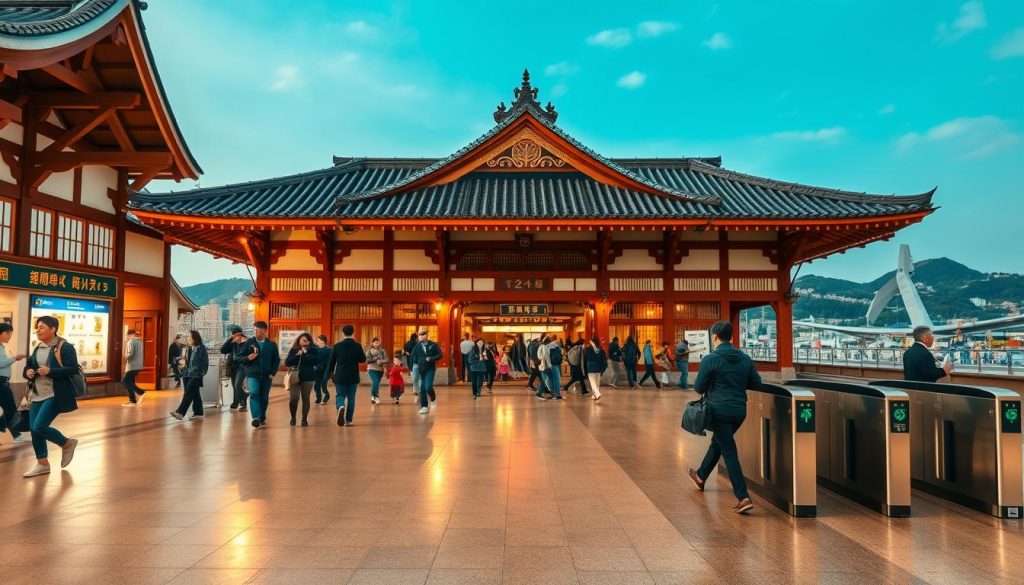
Conclusion
Your journey through this historic destination offers a perfect blend of past and present. From ancient temples to serene beaches, every corner tells a story. This guide has highlighted the great experiences that make this place truly special.
Whether you’re planning a day trip or an extended stay, the unique mix of history, nature, and modern attractions ensures there’s something for everyone. Use this guide as your starting point to explore the hidden gems and iconic landmarks that define this great destination.
Take the time to wander through lush gardens, savor local flavors, and immerse yourself in the culture. This is your way to create unforgettable memories. Let this guide inspire you to discover everything this historic town has to offer.
The above is subject to change.
Check back often to TRAVEL.COM for the latest travel tips and deals.
Here are some Tours & Sightseeing suggestions that might pique your interests!
